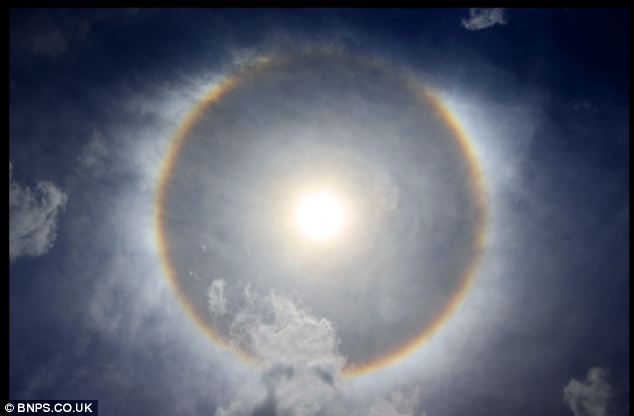
But the spectacular sight of the sun surrounded by a mysterious halo is known as a 'sun dog'.
The phenomenon, which had beachgoers in Bournemouth gazing at the sky yesterday, occurs when sunlight is refracted by hexagonal-shaped ice crystals in high and cirrus clouds - and is quite common.
Comment: It is interesting to note that a competing version of this story actually classifies this as a "rare phenomenon"
This picture was taken from Bournemouth beach in Dorset by photographer Chris Skone-Roberts.
The phenonemen is officially called a pathelia but is also known as a 'halo' or 'mock sun'.
The sun was partly obscured by high cirrus clouds. 'Sun dogs' are more commonly seen when the sun is low in the sky and not in the middle of the day.
Mr Skone-Roberts. 40, from Bournemouth, said: 'It was a nice day and I went with some friends to the beach.
'It was just after 1pm and I looked up and saw the halo around the sun. They're very rare and are not often complete.
'Lots of people were trying to get photographs of it on their phones, but that's not easy to do.
'I used a UV filter and managed to get a picture. You need a 10-20mml lens. It looked spectacular.'
Richard Wild, from Bournemouth-based weather forecasters Weathernet, said: 'Sun dogs, halos or mock suns are caused by the sun shining through ice crystals or cirrus clouds.
'Depending on the orientation and quantity of the ice crystals and the quantity of cirrus clouds in the sky, these ice crystals act like prisms bending the sunlight to result in a ring around the sun and, depending on the height of the sun, determines the shape of the halo.'
Cultures around the globe have traditionally given great significance and meaning to a sun dog when they see one.
A sun dog is believed to have appeared in the sky before the Battle of Mortimer's Cross, one of the most impossible battles during the War of the Roses in 1461.
The Yorkist leader, who later became Edward IV, convinced his nervous troops that the strange sight was a good omen and won a decisive victory.



Never seen one before, so perhaps it is location oriented? Such as close to areas/topographies subject to such ice formation in the atmosphere?